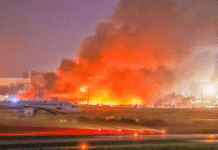North-eastern district town Sylhet is among 13 Himalayan towns set to witness their safe water sources become scarce by 2050, according to a new study released on Sunday.
The study was published in Water Policy, the official journal of the World Water Council, a French association.
The Nepal-based International Centre for Integrated Mountain Development led the study on the 13 towns in Bangladesh, India, Nepal and Pakistan.
The study said that Bangladesh’s north-eastern district town Sylhet was likely to face more floods in the coming years because of extreme climatic events.
Drainage and other related infrastructure to protect Sylhet against flooding and waterlogging might need frequent improvements, perhaps once every five years, because of extreme climatic events, said the study.
Disposal of wastewater and solid waste directly into water bodies would render water mostly undrinkable while groundwater reserves would exhaust meeting the demand, said the study.
The situation is almost similar in Bharatpur, Nepal.
‘Residents need to change their behaviour and manage the municipal solid waste properly, including plastic waste,’ said Dr Mani Nepal, lead economist, SANDEE-ICIMOD, Kathmandu.
The study called on policymakers to allocate more funds for managing water resources better to prevent an impending disaster.
The study said that the hydrological regimes in the Hindu Kush Himalayan region was undergoing changes because of landslides and glacier melt caused by extreme rainfall and an increase in average temperature.
A press release issued on the occasion of release of the study said that it aimed at filling the knowledge gap about the status of water resources and water supply in Himalayan towns.
It said that unplanned and haphazard development in the region is leading to problems of inequity in water supply and unequal developmental outcomes.
Communities are coping via short-term strategies such as groundwater extraction which is proving to be unsustainable, said the press release.
The study said that there are more than a million perennial springs in the Indian Himalayan region alone, feeding aquifers, rivers and other water sources.
But many of the springs disappeared or are on the verge of being disappeared because of human interventions like sand mining and other development activities, the study said.
Although only 3 per cent people in the studied region live in large cities and 8 per cent in small towns at the moment by 2050 about 50 per cent people would live in urban areas, said the study.
But water demand-supply gap already as high as 70 per cent in some of the studied towns such as Mussoorie, Darjeeling and Kathmandu, said the study.
About 20 per cent of Kathmandu’s poor households do not have access to the formal water supply system and they end up paying more for accessing water as compared to the richer households who have access.
The study concluded that the demand for water is outstripping supply in almost all the towns and the future looks bleak if the business as usual scenario persists.
Estimating and planning according to the seasonal carrying capacity of cities, waste management and springshed management are keys to meeting future water demands, it said.
The towns studied include Sylhet and Chattogram in Bangladesh; Mussoorie, Devprayag, Singtam, Kalimpong, and Darjeeling in India; Kathmandu, Bharatpur, Tansen, and Damauli in Nepal; and Murree and Havelian in Pakistan.
International Centre for Climate Change and Development director Saleemul Huq said that climate change impacts would cause drought and flooding in certain areas of Bangladesh every year.
‘It would be a big deal if Bangladesh does not learn to manage its water resources,’ said Saleemul Huq.










